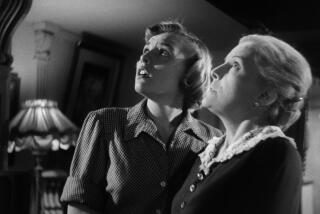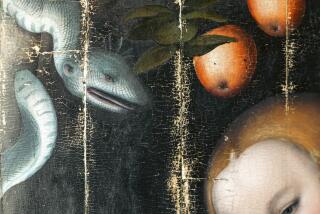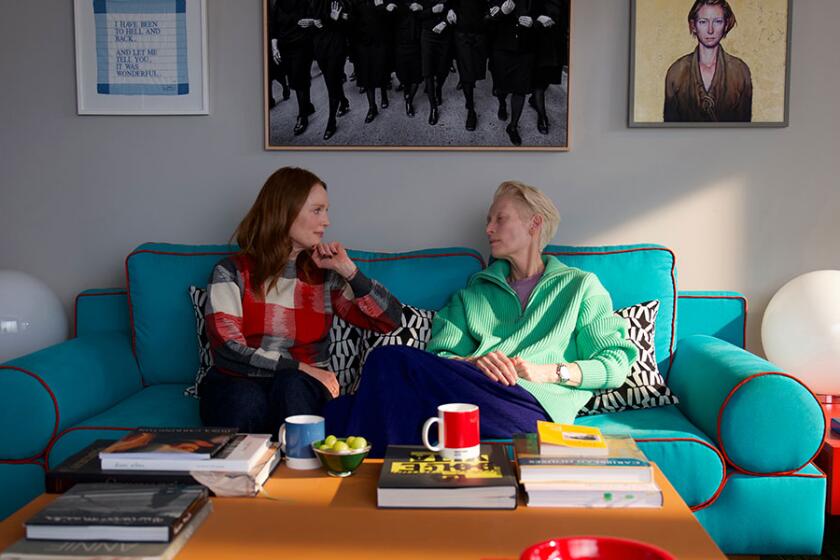‘Window’ Dressing
- Share via
First “Vertigo” was brought back from oblivion; now the ever-popular “Rear Window” is the latest Alfred Hitchcock classic starring Jimmy Stewart being saved from the ravages of time.
To enhance its image quality, the restored version will be among the first films printed in Technicolor’s new dye-transfer process (so far used only experimentally with a few prints of Warner Bros.’ “Giant” reissue and “Batman & Robin”).
This marks the third Universal Pictures restoration by the team of Robert Harris and James Katz, following “Spartacus” and “Vertigo”--less expensive than their large-format projects (“Vertigo,” for example, cost $1.3 million) but no less intensive.
“Like ‘Vertigo,’ we can make ‘Rear Window’ look like it’s never looked before, with rich colors to show off the new process,” says Katz, who produces the restorations. “This serves the future without forgetting the past.”
Indeed, as Technicolor gears up for next year’s high-tech return of dye transfer (abandoned since the mid-1970s)--which has suddenly become cost-effective in the current “event” film market--the “Rear Window” announcement proves that the process can also accommodate special reissues as well.
According to Frank Ricotta, Technicolor’s senior vice president of worldwide technical and engineering operations, the new process yields sharper, less grainy prints than conventional color positive prints, as well as “an extended tone scale resulting in blacker blacks, whiter whites and improved color rendition.”
The restorers concur that the results are impressive. “ ‘Rear Window’ is a dark-looking movie,” Katz says. “And in the tests, we’ve been getting a lot of detail in the blacks you don’t ordinarily see. There’s also increased sharpness. You can see it in the bricks on the buildings [in the courtyard] and in the patterns on the dresses.”
“It also saves the restoration negative for you,” says Harris, who performs the actual restorations. “You can’t go back to make dupes because it is a restoration negative made up of bits and pieces, but with dye transfer you make a few trial prints [for color timing] and you have your matrices to make your release prints from. And dye-transfer prints don’t fade.”
Actually, “Rear Window” has never looked as good as it could have, according to Harris, even during its initial release, in 1954. That’s because the first dye-transfer prints weren’t made until the 1962 reissue, when they were badly timed and came out beige. “So this will be the first time we see the film’s full-color spectrum,” he says.
But first the restorers must clean up an extremely dirty negative, abused from the very beginning. “It’s a mess,” Harris says. “There were 400 runs off the camera negative before the end of 1954. We don’t know why they didn’t do it dye-transfer, which would have saved printing off the negative. This was reasonably unusual for the period. And we’re missing 1,000 feet of negative.”
It is ironic that “Rear Window” has suffered this fate, considering it was one of Hitchcock’s personal favorites and his most successful film of the ‘50s (the first movie from his peak Paramount period, which he eventually owned outright and later withdrew for a decade). When last reissued, in 1983, “Rear Window” grossed an additional $9.1 million for Universal, which acquired it from Hitchcock’s estate.
Inspired by Cornell Woolrich’s cunning short story about murder, voyeurism and confined spaces, the director was obviously at his crafty best. He had all the technical toys he desired at his disposal, plus two of his favorite stars, Jimmy Stewart and Grace Kelly. Also, “Rear Window” was Stewart’s favorite of the four films he made with the director.
Yet were it not for a recent technological breakthrough conceived by the restorers and developed by Phil Feiner, executive vice president of Pacific Title film lab, a complete restoration of “Rear Window” would not have been achievable.
Besides the accumulation of dirt, pieces of the original Eastmancolor negative that were dupes (titles and optical effects) have faded in the crucual yellow layer of emulsion due to aging and improper storage--a malady that sooner or later strikes all color negatives from the early ‘50s through the ‘80s, when a more stable stock was introduced. This first layer deterioration includes loss of contrast, blacks and shadows going blue and facial highlights turning, in the words of the restorers, “a lovely shade of crustacean.”
Compounding “Rear Window’s” problem is an additional reel of negative that had its yellow layer stripped off the emulsion when a lacquer that was applied and reapplied over the years to cover scratches was eventually removed.
“No one was malicious here,” Katz says. “The film was a victim of its environment over the years. It doesn’t stand alone. There are thousands of films out there like this. No one knew enough about the properties of emulsion or temperature control for color negatives.”
The restorers were first stymied by the yellow-layer problem last year when trying to correct the revelatory flashback in “Vertigo.” Frustrated by their inability to restore the sequence, they later approached Feiner about devising a solution for subsequent restorations.
Using test footage from “Rear Window” and the 1956 remake of “The Man Who Knew Too Much” (to be restored at a later date), Feiner spent six months implementing a cost-effective photo-chemical solution.
To bring “Rear Window’s” colorful brilliance back to life, an interpositive (an extremely fine-grain, low-contrast color duplicating element) will be made from what survives on the original negative and combined with what survives on the yellow separation master.
“This is something that’s going to benefit all of these pictures,” Katz adds. “All the damage seems to be in the yellow layer.”
The most important moment in “Rear Window” to benefit not only from the yellow-layer breakthrough but from the new dye-transfer process is Kelly’s seductive entrance--which over the years has developed a yellow-green tint. Stewart, the aloof photographer confined to a wheelchair because of a broken leg, is awakened in his apartment by her tender kiss. To prolong the kiss and make it appear more sensual, Hitchcock shot it in close-up and then double-printed each frame in slow-motion.
“That shot is going to be breathtaking in Technicolor,” Katz predicts. “When people first see her, they’ll understand why everyone who came into contact with her fell in love with her.”
The main title sequence, another casualty of yellow-layer fading, has already been repaired. “We used five different formulas to get the precise color for the main titles,” Harris says. “There’s a kind of Chinese red drop shadow that was difficult to reproduce. We finally got one that was acceptable using the yellow-layer method.”
(The original Paramount logo, incidentally, will return to the film’s beginning and end, linked, of course, with the rising and falling bamboo shades in Stewart’s apartment.)
While “Rear Window” lacks the stunning visual reputation of “Vertigo,” its technical virtuosity is legendary, boasting Hitchcock’s most elaborate set to re-create the Greenwich Village apartment complex where Stewart spies on his neighbors with his telephoto lens. The effect, as Francois Truffaut first observed, is like viewing ambiguous scenarios of love and marriage from tiny movie screens or TV sets.
It was all part of Hitchcock’s famous “pure cinema” scheme: creating tension between Stewart observing and being observed--and involving us in the suspense of waiting for him to get caught. In fact, the way he introduces Stewart and his neighbors through a series of serpentine camera movements is as succinct an example of visual exposition ever filmed.
“People don’t ordinarily think of ‘Rear Window’ as a stylish movie,” Katz says. “But what we’re discovering is that there is a style in the way Hitchcock used color. With Miss Lonelyhearts, we can now see the mauve in her apartment and the green in her dress. Each apartment has its own color style.”
Harris and Katz expect the restoration to be completed in the spring. However, Universal’s distribution plans could be complicated by a blackout currently in place until 1999 (coincidentally, the centenary of Hitchcock’s birth). Sheldon Abend, who owns the copyright on the Woolrich short story from which the film is based, won a landmark U.S. Supreme Court decision in 1990 declaring his copyright renewal was violated. “The important thing is, we’re saving another Hitchcock,” Katz adds. “And we have a whole new audience right now for this.”
More to Read
Only good movies
Get the Indie Focus newsletter, Mark Olsen's weekly guide to the world of cinema.
You may occasionally receive promotional content from the Los Angeles Times.










